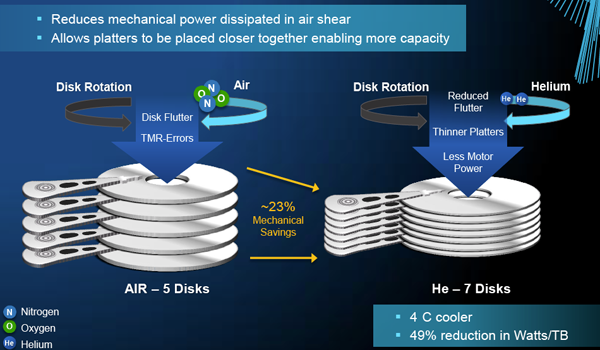Seagate is presently transporting
its 10TB helium-filled hard drive in volume, and it's hit this objective
without utilizing executive punishing advances like SMR (Shingled Magnetic
Recording). While early high-limit drives utilized SMR (an innovation in which
part of every track is overlaid on the other, looking like shingles), it
punishes drive composes contrasted and non-shingled opposite recording. SMR
helps densities, however it harms read execution, and later drives from all
sellers have moved back towards customary opposite recording.
Helium-fixed
hard drives have been constantly advancing into server farms and endeavor
drives. 10TB, Seagate is pushing the envelope on total drive limit too, with
seven drive platters and 14 heads altogether.
This slide is taken from a HGST
presentation, not Seagate, but rather it outlines why drive producers have
moved to helium as one strategy for enhancing undertaking HDDs. By cutting
resistance, they can stack more platters in a given space, accordingly
expanding drive thickness. Diminished resistance can likewise cut force
utilization; Seagate reports that helium HDDs can use as much as 2W less power
for every drive than ordinary HDDs. 2W won't seem like much, but rather on the
off chance that you have a variety of a few thousand drives, cutting force
utilization by 2W is a lot of investment funds that likewise lessens server
farm cooling load.
Part of what's driving this movement
to helium over the venture business is the proceeding with development of solid
state drives, or SSDs. While undertaking SSDs have been genuinely regularly
over the business for various years, worries about unwavering quality and cost
guaranteed that routine hard drives kept on controlling the general business
sector. Diminishing expenses and the approach of advancements like 3D NAND have
permitted organizations like Samsung to move back to more reputable 40nm
procedure innovation with predominant unwavering quality and general execution.
To put it plainly, 3D NAND/V-NAND can be used to make more dependable SSDs that
perform better over the long haul.
While it's valid there's still a
sizable hole amongst SSDs and HDDs in expense per-GB. That hole has been
contracting drastically as of late. 1TB SSDs can be had for as meager as $219.
The endeavor class SSDs that would contend with comparative items from HGST and
Seagate are unfathomably more costly. In both supreme cost and cost-per-GB —
however undertaking hard drives aren't precisely known for being reasonable,
either. List cost for a 6TB helium drive from HGST is presently ~$500, or
twofold the cost for a customer 6TB drive.
Pushing
drive limits upwards is one of the means undertaking makers can keep on
countering infringing SSDs. Helium drive tech is one capacity that is not
anticipated that would go to the mass business sector — the drives are
excessively troublesome, making it impossible to make to effectively scale the
innovation to the vicious universe of spending plan hard drives.


Post a Comment